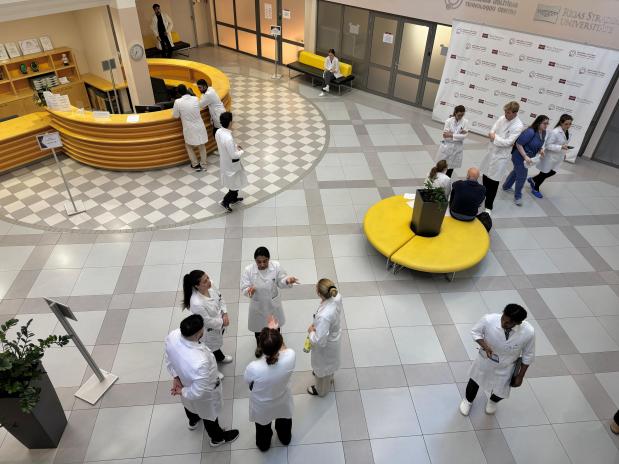RSU Faculty of Medicine is introducing a new examination format – in a simulation environment with simulated patients
On 28-29 May, at the Rīga Stradiņš University Medical Education Technology Centre (RSU METC), part of the graduating future doctors took one of the stages of the national examination in a new format – in a simulation-based environment with simulated patients. While international students of the Medicine study programme already tried this approach by interpreting a patient’s clinical case in a simulation environment with a simulated patient in the winter, Latvian students had the opportunity to take the examination in such format for the first time this spring.
Until now, the practical part of the national examination for all future doctors was conducted exclusively in medical institutions, assigned for each student randomly, for example, Riga East University Hospital, Pauls Stradiņš Clinical University Hospital (PSKUS), Children’s Clinical University Hospital, Hospital of Traumatology and Orthopaedics, the Riga Maternity Hospital, etc.
Although examinations in real healthcare institutions provide valuable experience for students, in recent years, the challenges associated with this format have become increasingly evident, requiring alternative solutions. While the number of students continues to grow, the capacity of healthcare institutions and patient availability are decreasing, primarily due to organisational, systemic, and legal restrictions.
The interpretation of a patient’s clinical case in a simulation environment with a simulated patient is a new and innovative approach in Latvian medical education. However, this method is widely recognised and established as an effective teaching and assessment practice in the world. One of the key advantages of this approach, in the context of examinations, is the possibility to avoid content-related and organisational restrictions, most notably, the lack of patients. Additionally, this method allows both the standardisation of the examination and objective and structured assessment of student performance. It is an opportunity to more accurately assess not only students' clinical knowledge, but also doctor-patient communication skills, clinical reasoning and decision-making ability, as well as professional competence within a safe and controlled setting close to a hospital environment.
To ensure the examination process, several simulated wards were set up at the RSU METC, namely paediatrics, obstetrics and gynaecology, infectology, surgery, traumatology and orthopaedics, and internal diseases. Students were randomly assigned to one of these wards, where they were met by a simulated patient - a specially trained person who, following a pre-designed scenario, recreated a specific clinical situation.
The examination was observed by Prof. Peter E. Goretzki, Member of RSU Council, and Assoc. Prof. Ingus Skadiņš, Vice-Dean of the Faculty of Medicine, who stated: ‘There is no doubt that simulations play a crucial role in both the learning and assessment processes.
Simulation scenarios, simulated patients, and teamwork in a simulated environment are not the future of medical education – it is the today’s reality and an integral part of a high-quality medical study process.
The new simulation-based examination format will be established as a permanent practice. The experience gained clearly demonstrates its value and potential - this examination format is an effective solution that will be systematically developed and refined to be integrated as part of the national examination process.’
The patient role-players who participated in the examination process also acknowledged that the students confidently demonstrated their knowledge and clinical skills, clearly confirming their readiness for professional challenges and the work in a real healthcare environment.
The RSU METC team is proud of the achievements and is confident that this examination format will become a standard practice in the future and will be also introduced in other healthcare study programmes.
Related news
 Learning from mistakes – RSU Faculty of Medicine launches reporting system to improve patient safety in clinical placementsAktualitātes
Learning from mistakes – RSU Faculty of Medicine launches reporting system to improve patient safety in clinical placementsAktualitātes


